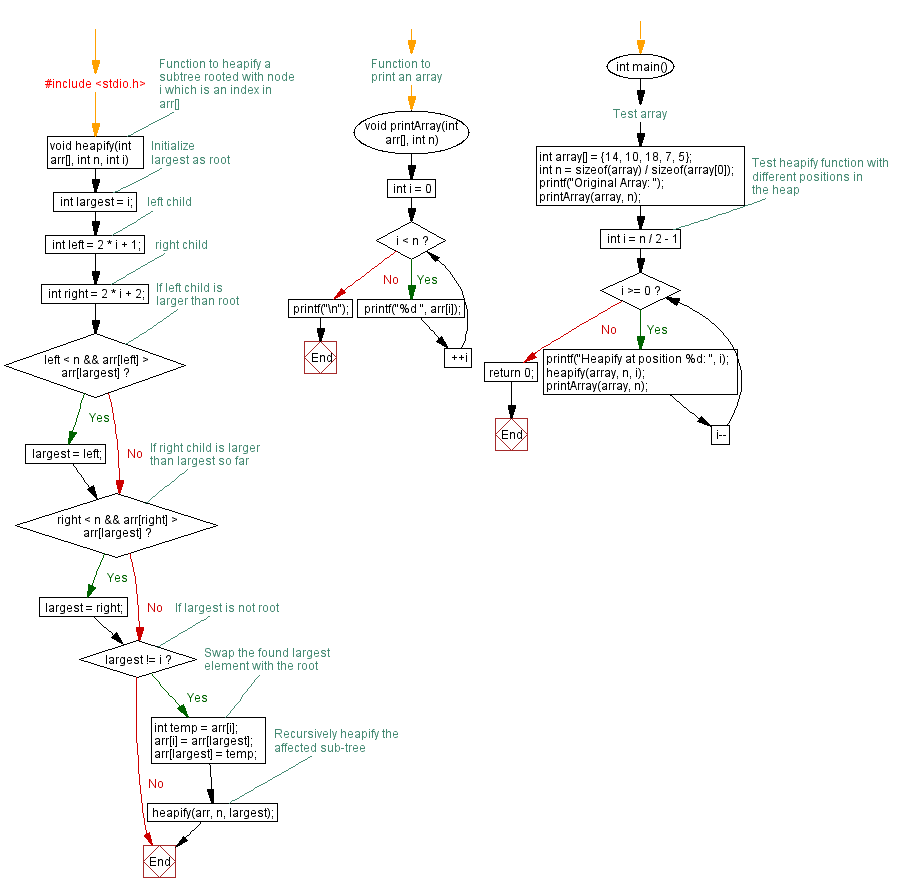C Program: Implementing and testing Heapify function
5. Heapify Function Extended Challenges
Write a C program that implements a function to heapify a given node in a heap. Check the function with different positions in the heap.
Sample Solution:
C Code:
#include <stdio.h>
// Function to heapify a subtree rooted with node i which is an index in arr[]
void heapify(int arr[], int n, int i) {
int largest = i; // Initialize largest as root
int left = 2 * i + 1; // left child
int right = 2 * i + 2; // right child
// If left child is larger than root
if (left < n && arr[left] > arr[largest])
largest = left;
// If right child is larger than largest so far
if (right < n && arr[right] > arr[largest])
largest = right;
// If largest is not root
if (largest != i) {
// Swap the found largest element with the root
int temp = arr[i];
arr[i] = arr[largest];
arr[largest] = temp;
// Recursively heapify the affected sub-tree
heapify(arr, n, largest);
}
}
// Function to print an array
void printArray(int arr[], int n) {
for (int i = 0; i < n; ++i)
printf("%d ", arr[i]);
printf("\n");
}
int main() {
// Test array
int array[] = {14, 10, 18, 7, 5};
int n = sizeof(array) / sizeof(array[0]);
printf("Original Array: ");
printArray(array, n);
// Test heapify function with different positions in the heap
for (int i = n / 2 - 1; i >= 0; i--) {
printf("Heapify at position %d: ", i);
heapify(array, n, i);
printArray(array, n);
}
return 0;
}
Output:
Original Array: 14 10 18 7 5 Heapify at position 1: 14 10 18 7 5 Heapify at position 0: 18 10 14 7 5
Explanation:
In the exercise above,
- heapify: This function takes an array, its size, and an index as input and ensures that the subtree rooted at that index maintains the max-heap property. It compares the node with its left and right children, swaps with the larger child if necessary, and recursively calls itself on the affected sub-tree.
- printArray: This function prints the elements of an array.
- In the main function:
- It initializes an array.
- Prints the original array.
- Test the heapify function with different positions in the heap, printing the array after each heapification process.
Flowchart:

For more Practice: Solve these Related Problems:
- Write a C program to implement a recursive heapify function and count the number of recursive calls made during the process.
- Write a C program to implement an iterative version of heapify and compare its efficiency with the recursive approach.
- Write a C program to heapify a node in a binary tree stored in an array and ensure that the entire heap property is maintained.
- Write a C program to implement a robust heapify function that can detect and correct a corrupted heap structure.
Go to:
PREV : Heap Sort Extended Challenges.
NEXT : Priority Queue Extended Challenges.
C Programming Code Editor:
Have another way to solve this solution? Contribute your code (and comments) through Disqus.
What is the difficulty level of this exercise?
Test your Programming skills with w3resource's quiz.
